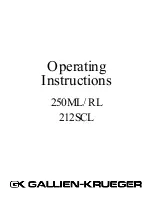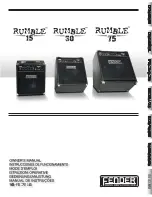
- 3 -
AMPLIFER CONTROLS Continued...
•
Input Sensitivity Adjustment:
This control adjusts the amplifier's input sensitivity.
Input sensitivity is variable from 100 Millivolts to 8 Volt. Turn the control
clockwise to increase sensitivity. Turning the control counter-clockwise will
decrease sensitivity. This control is not a volume control for the amplifier.
The amplifier can be driven to full power with a wide range of signal levels.
A low level signal will require increased sensitivity for full power. A high
level signal will require decreased sensitivity.
•
Low Level RCA Inputs
: These inputs are for signal cables from a source unit.
Always use high quality shielded RCA cables.
•
Variable Bass Boost:
By using the variable control, bass notes at 50 Hz are amplified
from 0dB to 18dB depending on the setting of the control. See Tuning your
system for more information on how Bass Boost works.
•
Selectable Crossover Switch
: Adjust the crossover for your chosen installation
method.
o
LPF: Low pass filter-only (40 Hz-250 Hz)
o
FULL: No filtering for speakers. For use with an external crossover.
o
HPF: High pass filter (40 Hz-250 Hz)
•
Variable Low-Pass Filter (40 Hz-250 Hz):
For use as a dedicated subwoofer
channel, set filter switch to "LPF". Adjust variable crossover frequency with
control as desired. The amplifier input circuit filters out everything above
40Hz to 250Hz (dependent on the adjustment of the frequency control), so
only the deepest bass notes are amplified.
•
Variable High-Pass Filter (40 Hz-250 Hz):
For use as a dedicated mid-range
channel, set filter switch to "HPF". The amplifier input circuit filters out
everything below 40Hz to 250Hz (dependent on the adjustment of the
frequency control), so only the deepest mid range notes are amplified.
•
Power Indicator LED
: This LED will illuminate when the amplifier is turned "ON”.
•
Protection Indicator LED
: This LED turns on when any of the following occurs:
o
Any speaker cable shorted to the vehicles chassis (ground).
o
Shorted speaker voice coil (zero impedance).
o
Combined speaker impedance is too low.(check wiring diagram)
o
Turns on due to excessive heat sink temperatures.
•
RCA Outputs
: These connections are used when connecting additional amplifiers.
- 4 -
PLANNING YOUR SYSTEM
•
If you plan to expand your system by adding other components sometime in the
future, ensure adequate space is left. If your head unit/source is equipped with Pre-
Amp outputs, it is possible to utilize them to drive this Amplifier.
•
Are your component speakers matched? The peak power rating of your speakers
must be equal or greater than the Amplifier’s. Speakers connect to this amplifier
must have a 4 Ohm impedance.
•
Consider both the length of your leads, and routing when determining the mounting
location. Pre-Amp input jacks require high quality shielded RCA patch cords.
MOUNTING YOUR SYSTEM
The mounting position of your amplifier will have a great effect on its ability to dissipate the
heat generated during normal operation. The HK Series amplifier has an efficient heat sink for
proper heat dissipation, also integrated with a thermal shutdown (for heat protection) circuit.
Allowing air around the cooling fins will improve heat dissipation dramatically. Do not enclose
the amplifier in a small box or cover it so that air cannot flow around the cooling fins.
Temperatures in car trunks have been measured as high as (158' F) in the summer
time. Since the thermal shut-down point for the Amplifier is (160' F) it must be mounted for
maximum cooling. To achieve maximum convection air flow in an enclosed trunk, mount the
amplifier in a vertical position, on a vertical surface.
Cooling requirements are considerably relaxed when mounting inside the passenger
compartment since the driver will not often allow temperatures to reach a critical point. Floor
mounting under the seat is usually satisfactory as long as there is at least 1 inch (2.54cm) above
the Amplifier's fins for ventilation.
To mount the Amplifier:
1.
Use the amplifier as a template to mark the mounting holes.
2.
Use extreme caution, inspect underneath surface before drilling.
3.
Remove the Amplifier and drill the marked holes.
4.
Secure the Amplifier using sheet metal or woods screw (whichever is applicable).


























